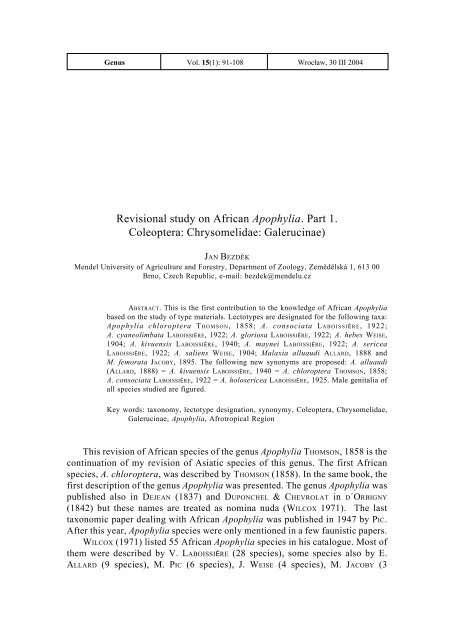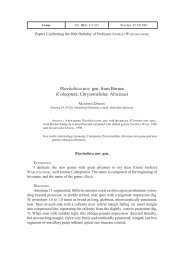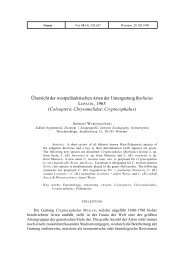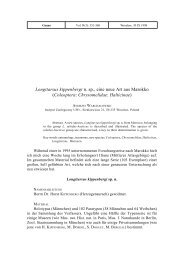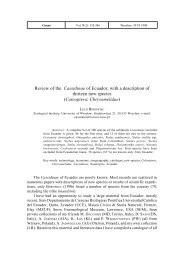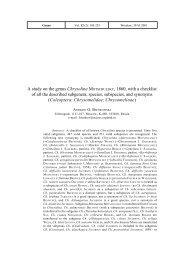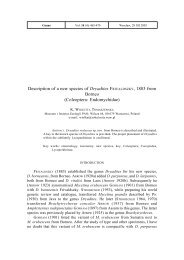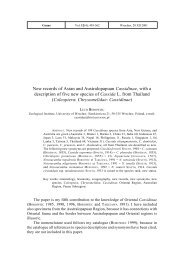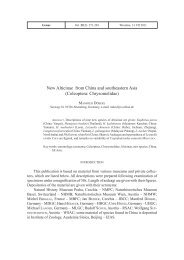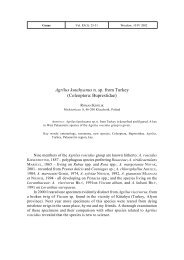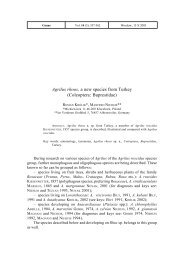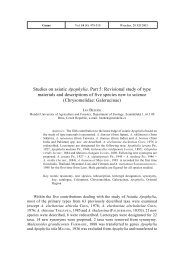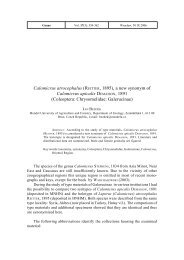Revisional study on African Apophylia. Part 1.
Revisional study on African Apophylia. Part 1.
Revisional study on African Apophylia. Part 1.
You also want an ePaper? Increase the reach of your titles
YUMPU automatically turns print PDFs into web optimized ePapers that Google loves.
Genus Vol. 15(1): 91-108 Wroc³aw, 30 III 2004<br />
<str<strong>on</strong>g>Revisi<strong>on</strong>al</str<strong>on</strong>g> <str<strong>on</strong>g>study</str<strong>on</strong>g> <strong>on</strong> <strong>African</strong> <strong>Apophylia</strong>. <strong>Part</strong> <strong>1.</strong><br />
Coleoptera: Chrysomelidae: Galerucinae)<br />
JAN BEZDÌK<br />
Mendel University of Agriculture and Forestry, Department of Zoology, Zemìdìlská 1, 613 00<br />
Brno, Czech Republic, e-mail: bezdek@mendelu.cz<br />
ABSTRACT. This is the first c<strong>on</strong>tributi<strong>on</strong> to the knowledge of <strong>African</strong> <strong>Apophylia</strong><br />
based <strong>on</strong> the <str<strong>on</strong>g>study</str<strong>on</strong>g> of type materials. Lectotypes are designated for the following taxa:<br />
<strong>Apophylia</strong> chloroptera T HOMSON, 1858; A. c<strong>on</strong>sociata L ABOISSIÈ RE, 1922;<br />
A. cyaneolimbata LABOISSIÈRE, 1922; A. gloriosa LABOISSIÈRE, 1922; A. hebes WEISE,<br />
1904; A. kivuensis LABOISSIÈRE, 1940; A. maynei LABOISSIÈRE, 1922; A. sericea<br />
LABOISSIÈRE, 1922; A. saliens WEISE, 1904; Malaxia alluaudi ALLARD, 1888 and<br />
M. femorata JACOBY, 1895. The following new syn<strong>on</strong>yms are proposed: A. alluaudi<br />
(ALLARD, 1888) = A. kivuensis LABOISSIÈRE, 1940 = A. chloroptera THOMSON, 1858;<br />
A. c<strong>on</strong>sociata LABOISSIÈRE, 1922 = A. holosericea LABOISSIÈRE, 1925. Male genitalia of<br />
all species studied are figured.<br />
Key words: tax<strong>on</strong>omy, lectotype designati<strong>on</strong>, syn<strong>on</strong>ymy, Coleoptera, Chrysomelidae,<br />
Galerucinae, <strong>Apophylia</strong>, Afrotropical Regi<strong>on</strong><br />
This revisi<strong>on</strong> of <strong>African</strong> species of the genus <strong>Apophylia</strong> THOMSON, 1858 is the<br />
c<strong>on</strong>tinuati<strong>on</strong> of my revisi<strong>on</strong> of Asiatic species of this genus. The first <strong>African</strong><br />
species, A. chloroptera, was described by THOMSON (1858). In the same book, the<br />
first descripti<strong>on</strong> of the genus <strong>Apophylia</strong> was presented. The genus <strong>Apophylia</strong> was<br />
published also in DEJEAN (1837) and DUPONCHEL & CHEVROLAT in D´ORBIGNY<br />
(1842) but these names are treated as nomina nuda (WILCOX 1971). The last<br />
tax<strong>on</strong>omic paper dealing with <strong>African</strong> <strong>Apophylia</strong> was published in 1947 by PIC.<br />
After this year, <strong>Apophylia</strong> species were <strong>on</strong>ly menti<strong>on</strong>ed in a few faunistic papers.<br />
WILCOX (1971) listed 55 <strong>African</strong> <strong>Apophylia</strong> species in his catalogue. Most of<br />
them were described by V. LABOISSIÈRE (28 species), some species also by E.<br />
ALLARD (9 species), M. PIC (6 species), J. WEISE (4 species), M. JACOBY (3
92 JAN BEZDÌK<br />
species), and 1 species by L. FAIRMAIRE, A. GERSTAECKER, J. THOMSON, J. C. W.<br />
ILLIGER, and G. E. BRYANT. Fortunately, the type series of all the species are<br />
c<strong>on</strong>centrated in <strong>on</strong>ly a few public instituti<strong>on</strong>s and will be revised subsequently. On<br />
the other hand, descripti<strong>on</strong>s of nearly half of the species are based <strong>on</strong>ly <strong>on</strong> females<br />
and the coordinati<strong>on</strong> of their males could be very troublesome.<br />
In the presented c<strong>on</strong>tributi<strong>on</strong> the first results of the revised primary types are<br />
commented. The lectotypes are designated for 11 taxa, 3 species are newly<br />
syn<strong>on</strong>ymized.<br />
The following abbreviati<strong>on</strong>s identify the collecti<strong>on</strong>s housing the material<br />
examined:<br />
BMNH - United Kingdom, L<strong>on</strong>d<strong>on</strong>, The Natural History Museum (Shar<strong>on</strong> SHUTE);<br />
DEI - Germany, Eberswalde Finow, Deutsches Entomologisches Institut (Lothar<br />
ZERCHE);<br />
ISNB - Belgium, Brussels, Institut Royal des Sciences Naturelles de Belgique<br />
(Didier DRUGMAND, Marcel CLUDTS);<br />
JBCB - Czech Republic, Brno, Jan BEZDÌK collecti<strong>on</strong>;<br />
MCSN - Italy, Genova, Museo Civico di Storia Naturale „Giacomo Doria”<br />
(Roberto POGGI);<br />
MCZC - USA, Massachusetts, Cambridge, Museum of Comparative Zoology<br />
(Phillip D. PERKINS);<br />
MRAC - Belgium, Tervuren, Musee Royal de l’Afrique Centrale (Mark DE MEYER);<br />
NHMB - Switzerland, Basel, Naturhistorisches Museum (Eva SPRECHER-UEBERSAX,<br />
Michel BRANCUCCI);<br />
RBCN - Netherlands, Nieuwegein, R<strong>on</strong> BEENEN collecti<strong>on</strong>;<br />
SMNS - Germany, Stuttgart, Staatliches Museum für Naturkunde (Wolfgang<br />
SCHAWALLER);<br />
TMSA - South Africa, Gauteng, Pretoria, Transvaal Museum (Ruth MULLER);<br />
UAGB – Germany, Berlin, Ulf ARNOLD collecti<strong>on</strong>;<br />
USNM - USA, Washingt<strong>on</strong> D.C., Nati<strong>on</strong>al Museum of Natural History (Alexander<br />
KONSTANTINOV);<br />
ZFMK - Germany, B<strong>on</strong>n, Zoologische Forschungsinstitut und Museum „Alexander<br />
Koenig” (Michael SCHMITT);<br />
ZMHB - Germany, Berlin, Museum für Naturkunde der Humboldt-Universität<br />
(Johannes FRISCH).<br />
When recording the label data of the type material examined, a double slash<br />
(//) divides data <strong>on</strong> different labels. The exact label data are cited for the type<br />
specimens. The type localities are cited in the original spelling. Other comments<br />
and complementati<strong>on</strong>s by the author are found in square brackets: [p] – preceding<br />
data are printed; [h] – the same, but handwritten; [w] - white label; x/y - number of<br />
males/number of females.
STUDY ON AFRICAN APOPHYLIA<br />
<strong>Apophylia</strong> carinata LABOISSIÈRE, 1922<br />
<strong>Apophylia</strong> carinata LABOISSIÈRE, 1922: Rev. Zool. Afr., 10: 241 (key), 253-254 (sep. 153, 165-166)<br />
(Type locality: Albertville); LABOISSIÈRE, 1925: 57; LABOISSIÈRE, 1940b: 16; WILCOX, 1971:<br />
143.<br />
TYPE MATERIAL EXAMINED<br />
Holotype (male), labelled: “HOLOTYPUS [red label, p] // Type [w, h, red<br />
letters] // MUSÉE DU CONGO Albertville XII-1918 R. Mayné [w, p] // R. DÉT.<br />
[p] R [h] 727 [w, p] // <strong>Apophylia</strong> carinata m m [h] V. Laboissière– Dét. [w, p]“ (in<br />
MRAC). The holotype is provided with <strong>on</strong>e red label: „HOLOTYPUS, <strong>Apophylia</strong><br />
carinata Laboissière, 1922, J. Bezdìk det. 2003”.<br />
Aedeagus as in Fig. <strong>1.</strong><br />
DISTRIBUTION<br />
C<strong>on</strong>go. I was unable to find any other material besides the holotype and the<br />
subsequently published females.<br />
COMMENTS<br />
A. carinata was described from <strong>on</strong>e male (LABOISSIÈRE, 1922). Nearly twenty<br />
years later, LABOISSIÈRE (1940b) published and designated additi<strong>on</strong>al 3 females as<br />
“Allotypes“. The three females, now deposited in MRAC, bear the following<br />
labels: “ALLOTYPE [p] carinata [red label, h] // COLL. MUS. CONGO Lulua:<br />
Luashi -XI-1938 F. Freyne [w, p] // R. DÉT. [p] C [h] 4091 [w, p] // V.<br />
Laboissière – det. 1940: [h] <strong>Apophylia</strong> carinata Labois allo-type [w, h]“. These<br />
specimens are c<strong>on</strong>sequently not treated as type material of A. carinata.<br />
<strong>Apophylia</strong> chloroptera THOMSON, 1858<br />
<strong>Apophylia</strong> chloroptera THOMSON, 1858: Arch. Ent. 2: 221-222 (Type locality: Gab<strong>on</strong> [by the title]);<br />
GEMMINGER & HAROLD, 1876: 3569; LABOISSIÈRE, 1922: 242 (key), 246 (sep. 154, 158); WEISE,<br />
1924: 183; LABOISSIÈRE, 1940b: 13 (key); BRYANT, 1958: 63; WILCOX, 1971: 143.<br />
<strong>Apophylia</strong> Chloroptera: ALLARD, 1889: LXXII (key) (sep. 7).<br />
Malaxia Alluaudi ALLARD, 1888: Ann. Soc. Ent. Fr. (6)8: 332 (Type locality: Assinie); ALLARD,<br />
1891: 558; syn. nov.<br />
<strong>Apophylia</strong> Alluaudi: LABOISSIÈRE, 1922: 242 (key) (sep. 154); WEISE, 1924: 183 (as syn. of A.<br />
chloroptera); LABOISSIÈRE, 1940b: 13 (key).<br />
<strong>Apophylia</strong> alluaudi: WILCOX, 1971: 142.<br />
<strong>Apophylia</strong> Kivuensis LABOISSIÈRE, 1940a: Expl. Parc Nat. Albert, Miss. de Witte (1933-35), 31: 23-<br />
24 (Type locality: Kivu: Rutshuru); LABOISSIÈRE, 1940b: 13 (key), 18; syn. nov.<br />
<strong>Apophylia</strong> kivuensis: WILCOX, 1971: 145.<br />
TYPE MATERIAL EXAMINED<br />
<strong>Apophylia</strong> chloroptera THOMSON, 1858<br />
Lectotype (female), designated here, labelled: “Coll. R. I. Sc. N. B. Gab<strong>on</strong><br />
[blue label <strong>on</strong> which two following labels are stuck, p] // Gabón [w, h] // Le Moult<br />
93
94 JAN BEZDÌK<br />
vend.: [w, p] // Le Moult vend. [h] <strong>Apophylia</strong> chloroptera Thoms. [w, p]“ (in<br />
ISNB). The lectotype is provided with <strong>on</strong>e red label: „LECTOTYPUS, <strong>Apophylia</strong><br />
chloroptera Thoms<strong>on</strong>, 1858, des. J. Bezdìk 2003”.<br />
Malaxia alluaudi ALLARD, 1888<br />
Lectotype (male), designated here, and 7 paralectotypes (females), labelled:<br />
“Assinie Afrique oc [blue label, h] // Coll. Alluaud [w, p] // Syntypus [red label, p]<br />
// Coll. DEI Eberswalde [w, p]“ (in DEI); paralectotype (female), labelled:<br />
“Assinie [blue label, h] // Assinie Afrique oc [blue label, h] // Coll. Alluaud [w, p]<br />
// Malaxia alluaudi All. Assinie [h] TYPE [grey label, red letters, h] // Syntypus<br />
[red label, p] // Coll. DEI Eberswalde [w, p]“ (in DEI); paralectotype (male),<br />
labelled: “Assinie Côté occid. Afrique Ch. Alluaud 1886 [w, p] // Coll. Alluaud<br />
[w, p] // Malaxia Alluaudi Alld. [w, h]// Syntypus [red label, p] // Coll. DEI<br />
Eberswalde [w, p]“ (in DEI); paralectotype (male), labelled: “Assinie Côte occid.<br />
Afrique Ch. Alluaud 1886 [w, p] // Jacoby Coll. 1909-28a. [w, p] // A. chloroptera<br />
Th. = alluaudi All. [h] det.K.G.Blair. [w, p]“ (in USNM). The specimens are<br />
1-2. Aedeagus (a - dorsal view, b - lateral view): 1 – <strong>Apophylia</strong> carinata, 2 – A. chloroptera; 3 –<br />
male mesotarsus of A. chloroptera. Scale 1 mm
STUDY ON AFRICAN APOPHYLIA<br />
provided with <strong>on</strong>e red label: „LECTOTYPUS [or PARALECTOTYPUS], Malaxia<br />
Alluaudi Allard, 1888, des. J. Bezdìk 2003”.<br />
<strong>Apophylia</strong> kivuensis LABOISSIÈRE, 1940<br />
Lectotype (male), designated here, and 120 paralectotypes (84 males, 36<br />
females), labelled: “LECTOTYPUS [PARA-LECTOTYPUS resp., red label, p] /<br />
/ MUSÉE DU CONGO Rutshuru [p] IV [h] –1937 J. Ghesquière [w, p] // R. DÉT.<br />
3619 [w, p]“ (in MRAC); paralectotype (female), labelled: “PARA-LECTOTYPUS<br />
[red label, p] // MUSÉE DU CONGO Kivu: Rutshuru [p] 9/11-VI-1934 [h] G. F.<br />
de Witte PARC NAT. ALBERT [w, p] // Type [red letters, p] f [h] // R. DÉT. [p]<br />
B [h] 4592 [w, p] // <strong>Apophylia</strong> kivuensis m [h] V. Laboissière – dét [w, p]“ (in<br />
MRAC); paralectotype (male), labelled: “PARA-LECTOTYPUS [red label, p] //<br />
MUSÉE DU CONGO Rutshuru [p] V [h] –1937 J. Ghesquière [w, p] // V.<br />
Laboissière – dét., 1939: [h] <strong>Apophylia</strong> kivuensis m Para-type [w, h]“ (in MRAC);<br />
3 paralectotypes (males), labelled: “PARA-LECTOTYPUS [red label, p] // MUSÉE<br />
DU CONGO Rutshuru [p] IV [h] –1937 J. Ghesquière [w, p] // R. DÉT. 3619 [w,<br />
p] // <strong>Apophylia</strong> kivuensis m. m [h] V. Laboissière. det 1939 [w, p]“ (in MRAC);<br />
paralectotype (male), labelled: “PARA-LECTOTYPUS [red label, p] // C<strong>on</strong>go<br />
belge: Kivu Rutshuru (riv. Fuku) 1250 m. 5-vii-1935 G. F. de Witte: 1621 [w, p]<br />
// COLL. MUS. CONGO // R. DÉT. [p] C [h] 4592 [w, p]“ (in MRAC); 3<br />
paralectotypes (1 male, 2 females), labelled: “PARA-LECTOTYPUS [red label,<br />
p] // C<strong>on</strong>go belge: Kivu Rutshuru (riv. Kanzarue) 1200 m. 16-vii-1935 G. F. de<br />
Witte: 1657 [w, p] // COLL. MUS. CONGO // R. DÉT. [p] C [h] 4592 [w, p]“ (in<br />
MRAC); paralectotype (female), labelled: “Coll. R. I. Sc. N. B. C<strong>on</strong>go belge [blue<br />
label <strong>on</strong> which <strong>on</strong>e following label is stuck, p] // Rutshuru (1285) [p] VII [h] 193<br />
[p] 5 [h] G. F. de Witte PARC NAT. ALBERT [w, p] // <strong>Apophylia</strong> Kivuensis m.<br />
1940 [h] V. Laboissière – Dét. [w, p] // Para-type [red label, p]“ (in ISNB); 2<br />
paralectotypes (1 male, 1 female), labelled: “Coll. R. I. Sc. N. B. [blue label <strong>on</strong><br />
which <strong>on</strong>e following label is stuck, p] // C<strong>on</strong>go belge: Kivu Rutshuru (Lubirizi)<br />
1285 m. 13-vii-1935 G. F. de Witte: 1644 [w, p] // V. Laboissière – det., 19 [p] 39<br />
[h] : [p] <strong>Apophylia</strong> kivuensis Laboiss. [w, h] // cf. Expl. P. N. A., G. F. de Witte<br />
(1933-1935), fasc. 31, 1940, p. [p] 23-24, fig. 7 [w, h]“ (in ISNB); paralectotype<br />
(male), labelled: “Coll. R. I. Sc. N. B. C<strong>on</strong>go belge [blue label <strong>on</strong> which <strong>on</strong>e<br />
following label is stuck, p] // C<strong>on</strong>go belge: Kivu Rutshuru (riv. Fuku) 1250 m. 5vii-1935<br />
G. F. de Witte: 1621 [w, p] // V. Laboissière – det., 1939: [h] <strong>Apophylia</strong><br />
kivuensis m [w, h] // cf. Expl. P. N. A., G. F. de Witte (1933-1935), fasc. 31, 1940,<br />
p. [p] 23-24, fig. 7 [w, h]“ (in ISNB); paralectotype (female), labelled: “Coll. R. I.<br />
Sc. N. B. C<strong>on</strong>go belge [blue label <strong>on</strong> which <strong>on</strong>e following label is stuck, p] //<br />
C<strong>on</strong>go belge: Kivu Rutshuru (riv. Kanzarue) 1200 m. 16-vii-1935 G. F. de Witte:<br />
1657 [w, p] // V. Laboissière – det., 19 [p] 39 [h] : [p] <strong>Apophylia</strong> kivuensis<br />
Laboiss. [w, h] // cf. Expl. P. N. A., G. F. de Witte (1933-1935), fasc. 31, 1940, p.<br />
[p] 23-24, fig. 7 [w, h]“ (in ISNB). The specimens are provided with <strong>on</strong>e red label:<br />
„LECTOTYPUS [or PARALECTOTYPUS], <strong>Apophylia</strong> Kivuensis Laboissière,<br />
1940, des. J. Bezdìk 2003”.<br />
95
96 JAN BEZDÌK<br />
ADDITIONAL MATERIAL EXAMINED<br />
BURUNDI: Kanna, 26-28.i.1926, H. SCHOUTEDEN leg. (1/1 in MRAC);<br />
CAMEROON: Kumba distr., Barombi lake, 14.-27.xi.1955, J. BECHYNÌ leg. (3/4<br />
in NHMB – Frey coll.); Nanga Eboko, Dr. LENCZY leg., 1959 (1/0 in USNM); 30<br />
km E Nanga-Eboko, 16.-19.ii.1972, at black light, J. A. GRUWELL leg. (1/1 in<br />
USNM); 10 km S of T<strong>on</strong>go, 2.-4.iii.1972, filtered black light, J. A. GRUWELL leg.<br />
(1/0 in USNM); 20 km E Minta, 20.ii.1972, at black light, J. A. GRUWELL leg. (0/<br />
1 in USNM); Libamba, 10 km E of Makak, 16.ix.1973, at black light, J. A.<br />
GRUWELL leg. (0/1 in USNM); same data, 20.-29.ix.1973, filtered black light (0/4<br />
in USNM); same data, 29.ix.1973, at black light (1/0 in USNM); same data, 3.-<br />
6.x.1973, filtered black light (0/2 in USNM); same data, 16.-26.x.1973, filtered<br />
black light (0/1 in USNM); same data, 7.-9.xii.1973, filtered black light (0/1 in<br />
USNM); same data, <strong>1.</strong>-2.iii.1974, at black light (0/4 in USNM); same data, 2<strong>1.</strong>-<br />
25.vi.1974, filtered black light (0/4 in USNM); same data, 18.-19.vi.1974, filtered<br />
black light (0/1 in USNM); same data, 26.vii.1974, filtered black light (0/4<br />
in USNM); Yaounde, v.1980 (0/3 in RBCN); Ebolowa, 5.v.1912, S. G. ROTHKIRCH<br />
leg. (1/1 in ZMHB); Soppo, 25.ii.1912, S. G. ROTHKIRCH leg. (1/0 in ZMHB);<br />
CONGO: Moyen C<strong>on</strong>go (0/1 in ZSNM); Secteur Nord, Kyanika vill., sur piste<br />
Ruwenzori, 1 320 m, 26.ix.1957, P. VANSCHUYTBROECK leg. (1/0 in MRAC); Kivu,<br />
Rutshuru, Kanzarue riv., 1 200 m, 15.vii.1935, G. F. DE WITTE leg. (2/1 in<br />
MRAC); Kivu, Rutshuru, Lubirizi, 1 285 m, 13.vii.1935, G. F. DE WITTE leg. (0/1<br />
in MRAC); Haut Uele, Moto, 1922, L. BURGEON leg. (0/1 in MRAC); Haut Uele,<br />
Watsa, xi.1919, L. BURGEON leg. (1/0 in MRAC); C<strong>on</strong>go da Lemba, iv.1911, R.<br />
MAYNÉ leg. (1/0 in MRAC); GHANA: Ntr<strong>on</strong>ang, 2.ii.1975, K. ADLBAUER leg. (1/1<br />
in ZFMK); Accra (<strong>on</strong> plane), 14.vii.1943 (1/0 in USNM); Takoradi, iv.-xi.1967,<br />
BESNARD leg. (2/0 in MRAC); Axim, BESNARD leg. (0/1 in MRAC); GUINEA:<br />
Kindia regi<strong>on</strong>, Gangan Mt., 3.-18.v. 1951, J. BECHYNÌ leg. (1/2 in NHMB – Frey<br />
coll.); Kankan, <strong>1.</strong>vii.1951, J. BECHYNÌ leg. (0/1 in NHMB – Frey coll.); Gand<strong>on</strong><br />
Mt., 24.vi.1984, S. V. MURZIN leg. (1/1 in SMNS); GUINEA EQUATORIAL:<br />
Andok, J. ROIO leg. (0/1 in USNM); M<strong>on</strong>go, 1946-1948, J. PALAU leg. (6/8 in<br />
MRAC); NIGERIA: Erin-odo waterfalls, 17.iii.1972, E. W. CLASSEY leg. (1/0 in<br />
BMNH); UGANDA: Ruwenzori Range, Kilembe, xii.1934-i.1935, light trap,<br />
4500 ft, F. W. EDWARDS leg. (1/0 in BMNH).<br />
Aedeagus as in Fig. 2.<br />
DISTRIBUTION<br />
Burundi, Camero<strong>on</strong>, C<strong>on</strong>go, Gab<strong>on</strong>, Ghana, Guinea, Guinea Equatorial, Ivory<br />
Coast, Nigeria, Uganda.<br />
COMMENTS<br />
A. chloroptera was designated as the type species of the genus <strong>Apophylia</strong> by<br />
LABOISSIÈRE (1922). I have found <strong>on</strong>ly <strong>on</strong>e type specimen (female) deposited in<br />
ISNB. Because THOMSON (1858) did not menti<strong>on</strong> the number of available speci-
STUDY ON AFRICAN APOPHYLIA<br />
mens, I designate this female as lectotype. Subsequently described species,<br />
A. alluaudi and A. kivuensis, are morphologically identical (including the structure<br />
of aedeagus) and the lectotypes for both are designated here. WEISE (1924)<br />
listed A. alluaudi as a synomym of A. chloroptera. Later, LABOISSIÈRE (1940b)<br />
treated A. alluaudi as a valid species in his key. Because I am unable to discover<br />
any difference between the females of A. alluaudi and A. kivuensis and the female<br />
lectotype of A. chloroptera, both subsequent species are c<strong>on</strong>sidered new syn<strong>on</strong>yms<br />
of A. chloroptera.<br />
Besides the characteristic structure of the aedeagus, the males can be easily<br />
distinguished from their c<strong>on</strong>geners by the peculiar shape of the basimesotarsus<br />
(Fig. 3). Within the genus <strong>Apophylia</strong> and relative genera, a similar (but deeper)<br />
incisi<strong>on</strong> of basimesotarsus is known <strong>on</strong>ly in Bequaertinia incisitarsis LABOISSIÈRE,<br />
1922.<br />
<strong>Apophylia</strong> cyaneolimbata LABOISSIÈRE, 1922<br />
<strong>Apophylia</strong> cyaneolimbata LABOISSIÈRE, 1922: Rev. Zool. Afr., 10: 245 (key), 258-259 (sep. 157<br />
(key), 170-171) (Type locality: Régi<strong>on</strong> des Lacs; C<strong>on</strong>go da Lemba); LABOISSIÈRE, 1925: 57;<br />
LABOISSIÈRE, 1929: 340; LABOISSIÈRE, 1940b: 14 (key); WILCOX, 1971: 143.<br />
TYPE MATERIAL EXAMINED<br />
Lectotype (male), designated here, labelled: “LECTOTYPUS [red label, p] //<br />
MUSÉE DU CONGO Régi<strong>on</strong> des Lacs Dr. Sag<strong>on</strong>a [w, p] // <strong>Apophylia</strong><br />
cyaneolimbata m m [h] V. Laboissière – Dét. [w, p] // R. DÉT [p] F [h] 728 [w, p]<br />
// Type [w, h, red letters]“ (in MRAC); paralectotype (female), labelled: “PARA-<br />
LECTOTYPUS [red label, p] // Type [w, h, red letters] // MUSÉE DU CONGO<br />
Régi<strong>on</strong> des Lacs Dr. Sag<strong>on</strong>a [w, p] // R. DÉT [p] F [h] 728 [w, p] // <strong>Apophylia</strong><br />
cyaneolimbata fm. [h] V. Laboissière– Dét. [w, p]“ (in MRAC); paralectotype<br />
(female), labelled: “TYPE [p] var. [red label, h] // MUSÉE DU CONGO C<strong>on</strong>go da<br />
Lemba 1913 R. Mayné [w, p] // R. DÉT [p] G [h] 728 [w, p] // <strong>Apophylia</strong><br />
cyaneolimbata Var. m. [h] V. Laboissière – Dét. [w, p]“ (in MRAC); paralectotype<br />
(male), labelled: “m [w, p] // Coll. R. I. Sc. N. B. C<strong>on</strong>go belge [blue label <strong>on</strong><br />
which two following labels are stuck, p] // Régi<strong>on</strong> des Lacs [w, p] // Dr. Sag<strong>on</strong>a<br />
[w, p] // <strong>Apophylia</strong> cyaneolimbata m 1922 m [h] V. Laboissière – Dét. [w, p] //<br />
Para-type [red label, p]“ (in ISNB). The specimens are provided with <strong>on</strong>e red<br />
label: „LECTOTYPUS [or PARALECTOTYPUS] <strong>Apophylia</strong> cyaneolimbata<br />
Laboissière, 1922, des. J. Bezdìk 2003”.<br />
ADDITIONAL MATERIAL EXAMINED<br />
CAMEROON: Dschang, 1 400 m, x.1912, S. G. ROTHKIRCH leg. (1/0 in<br />
ZMHB); Joh.-Albrechtshöhe, <strong>1.</strong>ix.-3<strong>1.</strong>x.1897, S. CONRADT leg. (1/2 in ZMHB);<br />
CONGO: Mambasa, i.1972, J. TAVERNIERS leg. (1/0 in MRAC); Kisangani, iii.1972,<br />
J. TAVERNIERS leg. (1/0 in MRAC); Ruwenzori Mts., Kakalari riv., affl. Bombi, 1<br />
725 m, 10.vi.1954, P. VANSCHUYTBROECK & H. SYNAVE leg. (1/0 in MRAC);<br />
97
98 JAN BEZDÌK<br />
Secteur Nord, Bumali, village pres Mutwanga, 1 300 m, 28.xi.1956, P.<br />
VANSCHUYTBROECK leg. (1/0 in MRAC); Secteur Nord, Mukandwe riv., Talya, 1<br />
400 m, 3.viii.1957, P. VANSCHUYTBROECK leg. (1/0 in MRAC); Yangambi, v.1952,<br />
J. DECELLE leg. (1/0 in MRAC); Haut Uele, Moto, 1922, L. BURGEON leg. (1/0 in<br />
MRAC); GUINEA EQUATORIAL: Fernando Poo Isl., Basile, 400-600 m,<br />
viii.1901, L. FEA leg. (1/2 in MCSN); Fernando Poo Isl., Musola, 500-800 m,<br />
iii.1902, L. FEA leg. (0/1 in MCSN); Uellebg. Benitob, 15.-3<strong>1.</strong>i.1907, G. TESSMAN<br />
leg. (1/0 in ZMHB); UGANDA: Semuliki N. P., 670 m, 0°48´N 30°09´E, 5.-<br />
15.ii.1997, U. GÖLLNER leg. (1/0 in ZMHB)<br />
Aedeagus as in Fig. 4.<br />
DISTRIBUTION<br />
Camero<strong>on</strong>, C<strong>on</strong>go, Guinea-Equatorial, Uganda.<br />
COMMENTS<br />
<strong>Apophylia</strong> cyaneolimbata can be distinguished from its c<strong>on</strong>geners by the<br />
structure of the aedeagus (Fig. 4), by the prol<strong>on</strong>ged and crescent-shaped male<br />
basimesotarsus, by the very l<strong>on</strong>g male basimetatarsus, 2.3 times as l<strong>on</strong>g as the two<br />
4-5. Aedeagus (a - dorsal view, b - lateral view): 4 - <strong>Apophylia</strong> cyaneolimbata, 5 - A. femorata.<br />
Scale 1 mm
STUDY ON AFRICAN APOPHYLIA<br />
following metatarsomeres combined. The general shape of male antennae<br />
(antennomeres 3 to 11 distinctly flattened) and length ratio of antennomeres 1 to<br />
11: 21-10-20-21-17-17-15-13-11-10-15, also seem to be important characters.<br />
<strong>Apophylia</strong> femorata (JACOBY, 1895)<br />
Malaxia femorata JACOBY, 1895: Trans. Soc. Ent. L<strong>on</strong>d., 1895: 340-341 (Type locality: South<br />
Africa (?)).<br />
<strong>Apophylia</strong> femorata: LABOISSIÈRE, 1922: 245 (key) (sep. 157); WEISE, 1924: 183; LABOISSIÈRE,<br />
1940b: 14 (key); WILCOX, 1971: 144.<br />
TYPE MATERIAL EXAMINED<br />
Lectotype (male), designated here, labelled: “2nd Jacoby Coll. [w, p] //<br />
sericea Boh. Caffr. [w, h] // Type [p] 18492 [red label, h] // Malaxia femorata<br />
Jacoby – Type [w, h]“ (in MCZC); 2 paralectotypes (males), labelled: “Type H. T.<br />
[white round label with red margin, p] // 89 [w, p] // Jacoby Coll. 1909-28a [w, p]<br />
// Malaxia femoralis Jac. Type [blue label, h]“ (in BMNH). The specimens are<br />
provided with <strong>on</strong>e red printed label: “LECTOTYPUS [or PARALECTOTYPUS],<br />
Malaxia femorata Jacoby, 1895, des. J. Bezdìk 2003“.<br />
ADDITIONAL MATERIAL EXAMINED<br />
RSA: Natal, Malvern, 24.ii.1902 (1/0 in USNM); Natal, Richm<strong>on</strong>d, Mahlaleen<br />
riv., xii.1959 E. HAAF leg. (4/1 in NHMB – Frey coll.); Caffrarie, SCHAUM leg. (2/<br />
0 in DEI); Port St. John, x.1923, R. E. TURNER leg. (1/0 in TMSA); Zululand,<br />
Hluhluwe Game Reserve, 28°05´S 32°04´E, 18.xi.1992, ENDRÖDY-YOUNGA leg.<br />
(1/0 in TMSA); Bashee Bridge CP, 3.xii.1956, R. M. MARTIN leg. (11/2 in<br />
TMSA); Natal, Richm<strong>on</strong>d distr., Umkoma riv. valley, <strong>1.</strong>xii.1956 (1/0 in MRAC).<br />
Aedeagus as in Fig. 5.<br />
DISTRIBUTION<br />
This species is known <strong>on</strong>ly from RSA.<br />
COMMENTS<br />
JACOBY (1895) described A. femorata according to an unspecified number of<br />
specimens. I have found altogether 3 syntypes (all males) deposited in MCZC and<br />
BMNH. The male from MCZC is designated as lectotype. A. femorata is well<br />
characterised by the very peculiar shape of aedeagus and by the colour of femora<br />
(basal 2/3 black).<br />
<strong>Apophylia</strong> gloriosa LABOISSIÈRE, 1922<br />
<strong>Apophylia</strong> gloriosa LABOISSIÈRE, 1922: Rev. Zool. Afr., 10: 245 (key), 259-260 (sep. 157 (key), 171-<br />
172) (Type locality: Régi<strong>on</strong> des Lacs); LABOISSIÈRE, 1925: 57; LABOISSIÈRE, 1940b: 15 (key);<br />
WILCOX, 1971: 144.<br />
99
100 JAN BEZDÌK<br />
TYPE MATERIAL EXAMINED<br />
Lectotype (male), designated here, labelled: “Coll. R. I. Sc. N. B. South<br />
Africa C<strong>on</strong>go belge [blue label <strong>on</strong> which two following labels are stuck, h] //<br />
Régi<strong>on</strong> des Lacs [w, p] // Dr. Sag<strong>on</strong>a [w, p] // <strong>Apophylia</strong> gloriosa m. 1922 [h] V.<br />
Laboissière – Dét. [w, p] // Para-type [red label, p]“ (in ISNB); paralectotype<br />
(female), labelled: “PARA-LECTOTYPUS [red label, p] // Type [w, h, red<br />
letters] // MUSÉE DU CONGO Régi<strong>on</strong> des Lacs Dr. Sag<strong>on</strong>a [w, p] // R. DÉT [p]<br />
H [h] 728 [w, p] // <strong>Apophylia</strong> gloriosa m. [h] V. Laboissière – Dét. [w, p]“ (in<br />
MRAC); paralectotype (male), labelled: “PARA-LECTOTYPUS [red label, p] //<br />
MUSÉE DU CONGO Régi<strong>on</strong> des Lacs Dr. Sag<strong>on</strong>a [w, p] // <strong>Apophylia</strong> gloriosa m.<br />
[h] V. Laboissière – Dét. [w, p] // R. DÉT [p] H [h] 728 [w, p]“ (in MRAC). The<br />
specimens are provided with <strong>on</strong>e red label: „LECTOTYPUS [or<br />
PARALECTOTYPUS] <strong>Apophylia</strong> gloriosa LABOISSIÈRE, 1922, des. J. Bezdìk<br />
2003”.<br />
ADDITIONAL MATERIAL EXAMINED<br />
CAMEROON: Joko, 1925 (1/0 in ISNB); Dschang, 1 400 m, x.1912, S. G.<br />
ROTHKIRCH leg. (3/0 in ZMHB); CONGO: Rutshuru, v.1927, J. GHESQUIÉRE leg. (1/<br />
0 in MRAC); Uelé, Bambesa, 20.ix.1933, J. LEROY leg. (1/1 in MRAC); same<br />
data, 15.x.1933 (0/1 in MRAC); same data, 30.ix.1933 (0/1 in MRAC); Uelé:<br />
Dingila, vi.1933, J. LEROY leg. (1/0 in MRAC); same data, <strong>1.</strong>viii.1933, H. J.<br />
BRÉDO leg. (1/0 in MRAC); Lomami-Kaniama, iii-iv.1932, R. MASSART leg. (1/0 in<br />
MRAC); Kilo, M<strong>on</strong>gbwalu, 1938, Mme SCHEITZ leg. (1/0 in MRAC); Kivu,<br />
Loashi, viii.1937, J. GHESQUIÉRE leg. (1/0 in MRAC); Haut-Uelé, Moto, 1923, L.<br />
BURGEON leg. (1/0 in MRAC); Stanleyville, Yangambi, v.1954, J. DECELLE leg. (3/<br />
3 in MRAC); same data, v. 1952 (3/0 in MRAC); Mambasa, i.1972, J. TAVERNIERS<br />
leg. (1/0 in MRAC); Kisangani, iii.1972, J. TAVERNIERS leg. (2/0 in MRAC); Hoyo<br />
Mt., gr. Kwama-Kwama, 1 230 m, 4.viii.1955, P. VANSCHUYTBROECK leg. (1/0 in<br />
MRAC); NIGERIA: S. Nigeria, 1913, A. D. PEACOCK leg. (3/0 in BMNH); S.<br />
Nigeria, Ilesha, 1911, L. E. H. HUMFREY leg. (1/0 in BMNH); Western State Ile-<br />
Ife, vi.1972, J. T. MEDLER leg. (1/0 in USNM); UGANDA: Masindi distr., Bud<strong>on</strong>go<br />
Forest near S<strong>on</strong>so, 1°45´N 31°35´W, <strong>1.</strong>-10.vii.1995, T. WAGNER leg. (1/0 in<br />
ZFMK).<br />
Aedeagus as in Fig. 6.<br />
DISTRIBUTION<br />
C<strong>on</strong>go, Camero<strong>on</strong>, Nigeria, Uganda.<br />
COMMENTS<br />
According to the original descripti<strong>on</strong>, A. gloriosa was decribed based <strong>on</strong> 3<br />
syntypes (2 males and 1 female) deposited in ISNB (1 male) and MRAC (1 male<br />
and 1 female). The male from ISNB is designated here as the lectotype.
STUDY ON AFRICAN APOPHYLIA<br />
<strong>Apophylia</strong> hebes WEISE, 1904<br />
101<br />
<strong>Apophylia</strong> hebes WEISE, 1904: Arch. Naturg., 70: 48 (Type locality: Ikuta); WEISE, 1907, 73: 216;<br />
LABOISSIÈRE, 1922: 240 (key), 253 (sep. 152, 165); WEISE, 1924: 183; WILCOX, 1971: 144.<br />
TYPE MATERIAL EXAMINED<br />
Lectotype (male), designated here, labelled: “Africa or. Ikutha [w, p]“ (in<br />
ZMHB); paralectotype (female), labelled: “Africa or. Ikutha [w, p] // <strong>Apophylia</strong><br />
hebes m. [w, h]“ (in ZMHB). The specimens are provided with <strong>on</strong>e red label:<br />
„LECTOTYPUS [or PARALECTOTYPUS], <strong>Apophylia</strong> hebes Weise, 1904, des.<br />
J. Bezdìk 2003”.<br />
ADDITIONAL MATERIAL EXAMINED<br />
KENYA: Rift Valley Mathews Range, ca. 35 km N Wamba, 1300-1400 m,<br />
1°10´707´´N 37°18´962´´E, 7.-12.xii.2002, C. HAUSER, D. BARTSCH & A. ZAHM<br />
leg. (3/13 in SMNS); Eastern Meru N.P., Bwather<strong>on</strong>gi Campsite near Park-<br />
Headquarter, 620 m, 0°09´870´´N 38°12´527´´E, 4.-6.xii.2002, C. HAUSER, D.<br />
BARTSCH & A. ZAHM leg. (6/10 in SMNS); Voi, 13.-17.xii.1997, M. SNÍZEK leg. (1/<br />
0 in RBCN); same data, 23.xi.1997 (1/1 in RBCN); same data, xi. 1997 (0/4 in<br />
JBCB); Nairobi, Oloitokitok, 30.xii.1945 (1/1 in MCSN).<br />
Aedeagus as in Fig. 7.<br />
DISTRIBUTION<br />
Kenya.<br />
COMMENTS.<br />
A. hebes was described from two specimens (male and female) collected in<br />
Ikuta (Kenya). The male is designated as lectotype. A. hebes and its closely<br />
related species A. saliens WEISE, 1904, are characterised by unusually exaggerated<br />
male hind femora resembling the femora of the subfamily Alticinae and by a<br />
furca-like male metasternal protuberance. This metasternal process is more slender<br />
in A. hebes (Fig. 8) and very robust in A. saliens (Fig. 9).<br />
<strong>Apophylia</strong> holosericea LABOISSIÈRE, 1925<br />
<strong>Apophylia</strong> holosericea LABOISSIÈRE, 1925: Encycl. Ent. (B) 1: 57 (replacement name for A. sericea<br />
LABOISSIÈRE, 1922, not FABRICIUS, 1798); BRYANT, 1958: 63; WILCOX, 1971: 144.<br />
<strong>Apophylia</strong> sericea LABOISSIÈRE, 1922: Rev. Zool. Afr., 10: 240 (key), 254-255 (sep. 152, 166-167)<br />
(Type locality: Riviére Tsavo, riviére Kerio, Campi Kiboko, J<strong>on</strong>ct. Camp., E. Elg<strong>on</strong>).<br />
<strong>Apophylia</strong> c<strong>on</strong>sociata LABOISSIÈRE, 1922: Rev. Zool. Afr., 242 (key) (sep. 154) (Type locality:<br />
Zanguebar); LABOISSIÈRE, 1925: 57; LABOISSIÈRE, 1940b: 11 (key); WILCOX, 1971: 143; syn.<br />
nov.<br />
TYPE MATERIAL EXAMINED<br />
<strong>Apophylia</strong> sericea LABOISSIÈRE, 1922
102 JAN BEZDÌK<br />
Lectotype (male), designated here, labelled: “LECTOTYPUS [red label, p] //<br />
MUSÉE DU CONGO [p] B. E. A. Campi Kiboko [h] Dr. Bayer [w, p] // R. DÉT.<br />
[p] U [h] 4091 [w, p]“ (in MRAC); paralectotype (female), labelled: “PARA-<br />
LECTOTYPUS [red label, p] // Type [red letters, w, p] // MUSÉE DU CONGO B.<br />
E. A.: Tsavo R. 4/21-V-1913 Dr. Bayer [w, p] // R. DÉT. [p] U [h] 4091 [w, p] /<br />
/ <strong>Apophylia</strong> sericea m. [h] V. Laboissière – Det. [w, p] // V. Laboissière vid.,<br />
1940: [p] <strong>Apophylia</strong> holosericea Labois (sericea Labois n<strong>on</strong> sericea Fab.) [w, h]“<br />
(in MRAC); paralectotype (female), labelled: “PARA-LECTOTYPUS [red label,<br />
6-7. Aedeagus (a - dorsal view, b - lateral view): 6 – <strong>Apophylia</strong> gloriosa, 7 – A. hebes; 8. male metasternal<br />
protuberance of A. hebes. Scale 1 mm
STUDY ON AFRICAN APOPHYLIA<br />
103<br />
p] // MUSÉE DU CONGO B. E. A.: J<strong>on</strong>ct. Camp – E. Elg<strong>on</strong> IV-V-1914 Dr. Bayer<br />
[w, p] // R. DÉT. [p] U [h] 4091 [w, p]“ (in MRAC); paralectotype (female),<br />
labelled: “PARA-LECTOTYPUS [red label, p] // Type [red letters, w, p] //<br />
MUSÉE DU CONGO B. E. A.: Kerio Riv. VI-1914 Dr. Bayer [w, p] // R. DÉT.<br />
[p] U [h] 4091 [w, p] // <strong>Apophylia</strong> sericea m. [h] V. Laboissière – Det. [w, p]“ (in<br />
MRAC); 3 paralectotypes (2 males, 1 female), labelled: “PARA-LECTOTYPUS<br />
[red label, p] // MUSÉE DU CONGO B. E. A.: Kerio Riv. VI-1914 Dr. Bayer [w,<br />
p] // R. DÉT. [p] U [h] 4091 [w, p]“ (in MRAC); paratype (female), labelled:<br />
“Coll. R. I. Sc. N. B. [blue label <strong>on</strong> which three following labels are stuck, p] //<br />
B.E.A.: Kerio Riv. [w, p] // VI. 1914 [w, p] // Dr. Bayer [w, p] // <strong>Apophylia</strong><br />
sericea m 1922 [h] V. Laboissière – Dét. [w, p] // Para-type [red label, p]“ (in<br />
ISNB). The specimens are provided with <strong>on</strong>e red label: „LECTOTYPUS [or<br />
PARALECTOTYPUS], <strong>Apophylia</strong> sericea Laboissière, 1922, des. J. Bezdìk 2003”.<br />
<strong>Apophylia</strong> c<strong>on</strong>sociata LABOISSIÈRE, 1922<br />
Lectotype (male), designated here, labelled: “Coll. R. I. Sc. N. B. [p] Ex Coll<br />
Laboissière [blue label <strong>on</strong> which <strong>on</strong>e following label is stuck, h] // Zanguebar<br />
[grey label, h] // <strong>Apophylia</strong> c<strong>on</strong>sociata m. 1922 [h] V. Laboissière – Dét. [w, p]<br />
// Holotype [red label, p]“ (in ISNB). The lectotype are provided with <strong>on</strong>e red<br />
label: „LECTOTYPUS, <strong>Apophylia</strong> c<strong>on</strong>sociata Laboissière, 1922, des. J. Bezdìk<br />
2003”.<br />
ADDITIONAL MATERIAL EXAMINED<br />
ETHIOPIA: Kaffa prov., Mui game res., 700 m, 10.iv.1972, R. O. S. CLARKE<br />
leg. (1/0 in MRAC); KENYA: Kibwezi, Hunters lodge, 2.xii.1997, M. SNÍZEK leg.<br />
(0/3 in UAGB, 0/1 in RBCN); Tsavo, East Buchuma, 28.xi.1997, M. SNÍZEK leg.<br />
(1/0 in RBCN); Kasigau Mts., Rukanga, 26.xi.1997, M. SNÍZEK leg. (1/0 in RBCN);<br />
Voi, 23.xi.1997, M. SNÍZEK leg. (5/1 in RBCN, 3/0 in JBCB); same data, 13.-<br />
17.xii.1997 (1/0 in RBCN); Garissa env., 30.xi.1999, M. SNÍZEK leg. (1/0 in JBCB);<br />
Taita, Mwatate env., 24.xi.1999, M. SNÍZEK leg. (1/0 in JBCB); 35 km N Wamba,<br />
Rift Valley, Mathews Range, 1300-1400 m, 1°10´707´´N, 37°18´962´´E, 7.-<br />
12.xii.2002, C. HÄUSER, D. BARTSCH & A. ZAHM leg. (2/8 in SMNS); Eastern<br />
Nyambeni Hills, Ngaja Forest, 1070 m, at light, 0°19´113´´N, 38°02´609´´E, 2.-<br />
4.xii.2002, C. HÄUSER, D. BARTSCH & A. ZAHM leg. (4/23 in SMNS); TANZANIA:<br />
Handeni, Makinda env., 14.iii.2002, M. SNÍZEK leg. (3/0 in JBCB); Pande env.,<br />
10.iii.2002, M. SNÍZEK leg. (8/9 in JBCB); Makata plain (Morogoro), 9.iii. 2002, M.<br />
SNÍZEK<br />
leg. (5/5 in JBCB); PATRIA?: B.E.A. [= British East Africa], Zuwani, 28-<br />
VI-1913, Dr. BAYER leg. (1/0 in MRAC); D.O.A. [= Deutsche Ost Afrika],<br />
Kwakiyambe, v.1916, METHNER leg. (1/1 in ZMHB).<br />
Aedeagus as in Fig. 10.<br />
DISTRIBUTION<br />
Ethiopia, Kenya, Tanzania.
104 JAN BEZDÌK<br />
COMMENTS<br />
Eight specimens from the type series of A. sericea were found (7 syntypes in<br />
MRAC, 1 syntype in ISNB). One of the male syntypes from MRAC is designated<br />
here as the lectotype. A. sericea LABOISSIÈRE, 1922 proved to be preoccupied by<br />
A. sericea (FABRICIUS, 1798) and was replaced by LABOISSIÈRE (1925) himself as<br />
A. holosericea.<br />
The descripti<strong>on</strong> of A. c<strong>on</strong>sociata is very brief in the identificati<strong>on</strong> key and was<br />
possibly omitted within the other descripti<strong>on</strong>s (LABOISSIÈRE, 1922). I have found<br />
<strong>on</strong>e male in ISNB whose label data fits the above short descripti<strong>on</strong>. The red label<br />
“Holotype“ was very probably added by the subsequent curator. The sec<strong>on</strong>d<br />
specimen deposited in MRAC is not a type specimen and it bears LABOISSIÈRE´s<br />
identificati<strong>on</strong> label of the year 1940. Because LABOISSIÈRE did not state the number<br />
of available specimens, I decided to designate here the male from ISNB as the<br />
lectotype.<br />
The examinati<strong>on</strong> of aedeagi of the primary types of both species showed no<br />
difference in the structure of male genitalia. LABOISSIÈRE (1922) distinguished<br />
A. c<strong>on</strong>sociata and A. sericea by the structure of elytral hairs which are recumbent<br />
and silk-like in A. sericea. The lectotype of A. c<strong>on</strong>sociata is nothing but a worn<br />
specimen of the same species. Both A. c<strong>on</strong>sociata and A. sericea were described<br />
in the same paper. According to ICZN (24.2.2.), the nomenclatorial priority is<br />
fixed by the first revising author. Due to the very short descripti<strong>on</strong> and of the <strong>on</strong>ly<br />
known type specimen of A. c<strong>on</strong>sociata, I decided to apply A. sericea as the senior<br />
syn<strong>on</strong>ym. A. c<strong>on</strong>sociata is c<strong>on</strong>sidered a new syn<strong>on</strong>ym of A. sericea. Due to the<br />
subsequent renaming the valid name of this species is A. holosericea.<br />
<strong>Apophylia</strong> maynei LABOISSIÈRE, 1922<br />
<strong>Apophylia</strong> Maynéi LABOISSIÈRE, 1922: Rev. Zool. Afr., 10: 244 (key), 255-256 (sep. 156 (key), 167-<br />
168) (Type locality: Albertville).<br />
<strong>Apophylia</strong> Maynei: LABOISSIÈRE, 1925: 58.<br />
<strong>Apophylia</strong> maynei: WILCOX, 1971: 146.<br />
TYPE MATERIAL EXAMINED<br />
Lectotype (male), designated here, and 2 paralectotypes (males), labelled:<br />
“LECTOTYPUS [or PARALECTOTYPUS, resp., red label, p] // Type [w, h, red<br />
letters] // MUSÉE DU CONGO Albertville XII-1918 R. Mayné [w, p] // R. DÉT.<br />
[p] D [h] 728 [w, p] // <strong>Apophylia</strong> Maynei m [h] V. Laboissière – Dét. [w, p]“ (in<br />
MRAC); 2 paralectotypes (males), labelled: “PARA-LECTOTYPUS [red label,<br />
p] // MUSÉE DU CONGO Albertville XII-1918 R. Mayné [w, p] // R. DÉT. [p] D<br />
[h] 728 [w, p] // <strong>Apophylia</strong> Maynei m [h] V. Laboissière – Dét. [w, p]“ (in<br />
MRAC); paralectotype (male), labelled: “m [w, p] // Coll. R. I. Sc. N. B. C<strong>on</strong>go<br />
belge [blue label <strong>on</strong> which three following labels are stuck, p] // Albertville [w, p]<br />
// XII-1918 [w, p] // R. Mayné [w, p] // <strong>Apophylia</strong> Maynei m 1922 [h] V.<br />
Laboissière – Dét. [w, p] // Para-type [red label, p]“ (in ISNB). The specimens are
STUDY ON AFRICAN APOPHYLIA<br />
105<br />
provided with <strong>on</strong>e red label: „LECTOTYPUS [or PARALECTOTYPUS],<br />
<strong>Apophylia</strong> Maynéi Laboissière, 1922, des. J. Bezdìk 2003”.<br />
ADDITIONAL MATERIAL EXAMINED<br />
CONGO: Lualaba, Kolwezi, v.1955, V. ALLARD leg. (1/1 in MRAC).<br />
Aedeagus as in Fig. 1<strong>1.</strong><br />
DISTRIBUTION<br />
C<strong>on</strong>go.<br />
COMMENTS<br />
A. maynei was described from 6 specimens deposited in MRAC (5 males) and<br />
ISNB (1 male). I designated <strong>on</strong>e of the males from MRAC as the lectotype.<br />
<strong>Apophylia</strong> saliens WEISE, 1904<br />
<strong>Apophylia</strong> saliens WEISE, 1904: Arch. Naturg., 70: 49 (Type locality: Abessynien); WEISE, 1907:<br />
216; LABOISSIÈRE, 1922: 239 (key) (sep. 151); WEISE, 1924: 183; WILCOX, 1971: 147.<br />
TYPE MATERIAL EXAMINED<br />
Lectotype (male), designated here, labelled: “Sobat Neuman [blue label, h] //<br />
m [w, h] // <strong>Apophylia</strong> saliens m. [w, h]“ (in ZMHB); paralectotype (female),<br />
labelled: “N. O.–Afrika O. Sudan, Sobat O. Neumann S. V. [blue label, p] // Sobat<br />
[w, h] // Malaxia saliens m. [w, h]“ (in ZMHB); 3 paralectotypes (females),<br />
labelled: “N. O.–Afrika O. Sudan, Sobat O. Neumann S. V. [blue label, p]“ (in<br />
ZMHB); paralectotype (female), labelled: “N. O.–Afrika O. Sudan, Tädo O.<br />
Neumann S. V. [blue label, p]“ (in ZMHB); paralectotype (female), labelled: “N.<br />
O.–Afrika O. Sudan, Tädo O. Neumann S. V. [blue label, p] // 2462 Tädo [w, h]“<br />
(in ZMHB); paralectotype (male), labelled: “m [w, h] // O. Sudan Adjuba I. U. O.<br />
Neumann [blue label, p]“ (in ZMHB); paralectotype (female), labelled: “O. Sudan<br />
Adjuba I. U. O. Neumann [blue label, p] // 2932 Adj. I. U. [w, h]“ (in ZMHB);<br />
paralectotype (female), labelled: “O. Sudan Adjuba I. U. O. Neumann [blue label,<br />
p]“ (in ZMHB). The specimens are provided with <strong>on</strong>e red label: „LECTOTYPUS,<br />
<strong>Apophylia</strong> saliens Weise, 1904, des. J. Bezdìk 2003”.<br />
ADDITIONAL MATERIAL EXAMINED<br />
SUDAN: Fung Prov., 10.ix.1930, H. B. JOHNSTON leg. (2/0 in BMNH); Wau<br />
(3/1 in ZMHB); Kodak, 2<strong>1.</strong>vii.1921 (1/0 in ISNB); Fachoda, Missi<strong>on</strong> Marchand,<br />
vii.1898, Dr. SMILY (0/1 in USNB); ETHIOPIA: Ilubabor prov., Gambela, 15.-<br />
17.xi.1972, R. O. S. CLARKE leg. (1/0 in MRAC).<br />
Aedeagus as in Fig. 12.
106 JAN BEZDÌK<br />
9. Male metasternal protuberance of <strong>Apophylia</strong> saliens; 10-12. Aedeagus (a - dorsal view, b - lateral<br />
view, c – ventral view): 10 - A. holosericea, 11 - A. maynei, 12 - A. saliens. Scale 1 mm
DISTRIBUTION<br />
Sudan, Ethiopia.<br />
STUDY ON AFRICAN APOPHYLIA<br />
107<br />
COMMENTS<br />
The original descripti<strong>on</strong> of A. saliens is very short and brief (WEISE, 1904)<br />
and it follows the descripti<strong>on</strong> of A. hebes. Abessynien [= Ethiopia] is indicated as<br />
the type locality of A. saliens. Three years later, WEISE (1907) somewhat improved<br />
the descripti<strong>on</strong> and cited the locality “Sobat (Neumann)“. Sobat is a river<br />
running from Ethiopia to Sudan.<br />
I had the opportunity to <str<strong>on</strong>g>study</str<strong>on</strong>g> the complete syntype series deposited in ZMHB<br />
collected by the expediti<strong>on</strong> of Oskar NEUMANN in 1902. According to the original<br />
labels, all the material is located in East Sudan. 5 specimens bear the label<br />
“Sobat“, 3 specimens “Adjuba“ and 2 specimens “Tädo“. One female from<br />
“Sobat“ also bears WEISE´s handwritten label “<strong>Apophylia</strong> saliens m.“. In my<br />
opini<strong>on</strong>, although WEISE (1904) cited “Abyssinien“, all 10 specimens collected<br />
by NEUMANN in Sudan refer to the original descripti<strong>on</strong>. I decided to designate <strong>on</strong>e<br />
male from “Sobat“ as the lectotype and the rest (9 specimens) as paralectotypes of<br />
A. saliens.<br />
One female from ISNB (Sudan: Fachoda) bears the label “Syntype“. Evidently,<br />
this label was added by a subsequent curator. This female is c<strong>on</strong>sequently<br />
not treated as type material.<br />
A. saliens can be easily distinguished by unusually extended male hind femora<br />
and by robust and a wide furca-like male metasternal protuberance (Fig. 9).<br />
ACKNOWLEDGEMENT<br />
I would like to express my thanks to all curators and collectors listed above<br />
for the possibility of examining the extensive material. The above investigati<strong>on</strong>s<br />
were realized within the frame of the AF MZLU MSM 43210000<strong>1.</strong><br />
REFERENCES<br />
ALLARD, E., 1888. Synopsis des Galerucines à corselet sill<strong>on</strong>né transversalement, 1 re partie. Ann.<br />
Soc. Entomol. Fr., (6)8: 305-332.<br />
—, 1889. Note sur les Galérucides, Coléoptères phytophages. Compt.-rend. Soc. Entomol. Belg.,<br />
33: LXVI-LXXXVII (sep. 1-18).<br />
—, 189<strong>1.</strong> Voyage de M. Ch. Alluaud dans le territoire d´Assinie (Afrique occidentale) en juillet et<br />
août 1886. Ann. Soc. Entomol. Fr., 59(1890): 555-558.<br />
BRYANT, G. E., 1958. Galerucinae (Coleoptera Chrysomelidae). Explor. Parc Nat. Albert, Miss. G. F.<br />
de Witte (1933-1935), Fasc. 49: 41-65.<br />
DEJEAN, P. F., 1837. Catalogue des Coléoptères de la collecti<strong>on</strong> de M. le Comte Dejean. Troisèmé<br />
éditi<strong>on</strong>, révue, corrigée et augmentée. Paris, XIV + 503 pp.<br />
GEMMINGER, D., HAROLD, B. DE, 1876. Catalogus Coleopterorum hucusque descriptorum syn<strong>on</strong>ymicus<br />
et systematicus. <strong>Part</strong> XII, M<strong>on</strong>achii, 3479-3822 + LXXIII.<br />
JACOBY, M., 1895. C<strong>on</strong>tributi<strong>on</strong>s to the knowledge of <strong>African</strong> phytophagous Coleoptera. <strong>Part</strong> II.<br />
Trans. Entomol. Soc. L<strong>on</strong>d<strong>on</strong>, 1895: 317-34<strong>1.</strong><br />
LABOISSIÈRE, V., 1922. Étude des Galerucini de la collecti<strong>on</strong> du Musée du C<strong>on</strong>go belge. Rev. Zool.<br />
Afr., 10: 219-271 (sep. 131-183).
108 JAN BEZDÌK<br />
—, 1925. Supplément au Catalogus Coleopterorum, pars 78 (Galerucinae), de J. Weise, précédé de<br />
remarques sur la classificati<strong>on</strong> des Galerucini. Encycl. Entomol., sér. B (Mémoires et notes),<br />
1: 33-62.<br />
—, 1929. Galerucini Africains de la collecti<strong>on</strong> du Musée Civique de Gênes. Ann. Mus. Civ. St. Nat.<br />
Genova, 53: 319-353.<br />
—, 1940a. Galerucinae (Coleoptera Phytophaga) Fam. Chrysomelidae. Explor. Parc Nat. Albert,<br />
Miss. G. F. de Witte (1933-1935), Fasc. 31: 1-93.<br />
—, 1940b. Galérucides des collecti<strong>on</strong>s du Musée du C<strong>on</strong>go belge. Rev. Zool. Bot. Afr., 34(1): 8-32.<br />
D´ORBIGNY, C., (ed.) 1842. Dicti<strong>on</strong>naire universel d´histoire naturelle. Tome 2. Bureau principal de<br />
l´editeur, Paris, 795 pp.<br />
THOMSON, J., 1858. Voyage au Gab<strong>on</strong>. Historie naturelle des Insectes et des Arachnides recueillis<br />
pendant un voyage fait au Gab<strong>on</strong> en 1856 et en 1857 par M. Henry C. Deyrolle sous les<br />
auspices de MM. le Comte de Mniszech et James Thoms<strong>on</strong> précédée de l´histoire du voyage.<br />
Archives Entomologiques ou recueil c<strong>on</strong>tenant des illustrati<strong>on</strong>s d´insectes nouveaux ou rares,<br />
II. Bureau du trésorier de la société entomologique de France, Paris, 469 pp.<br />
WEISE, J., 1904. Chrysomeliden und Coccinelliden aus Afrika. Arch. Naturg., 70: 35-62.<br />
—, 1907. Neue Chrysomeliden und Coccinelliden v<strong>on</strong>n der Ausbeute der Herren Oskar Neumann<br />
und Bar<strong>on</strong> v<strong>on</strong> Erlanger in Abyssinien. Arch. Naturg., 73: 210-232.<br />
—, 1924. Chrysomelidae: 13. Galerucinae. In: JUNK W. & SCHENKLING S. (eds.): Coleopterorum<br />
Catalogus, Pars 78. W, Junk, Berlin, 225 pp.<br />
WILCOX, J.A., 197<strong>1.</strong> Chrysomelidae: Galerucinae (Oidini, Galerucini, Metacyclini, Sermylini). In:<br />
WILCOX, J. A., (ed.): Coleopterorum Catalogus Supplementa. Pars 78(1), Sec<strong>on</strong>d editi<strong>on</strong>. W.<br />
Junk,´s-Gravenhage, 1-220.


